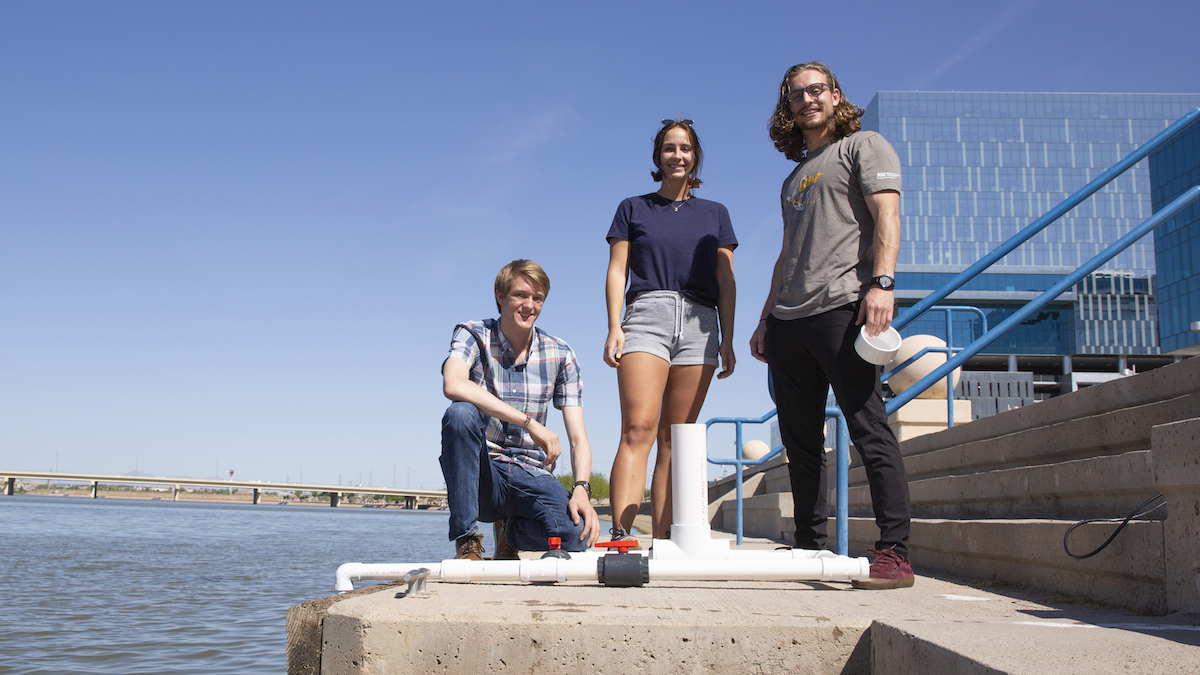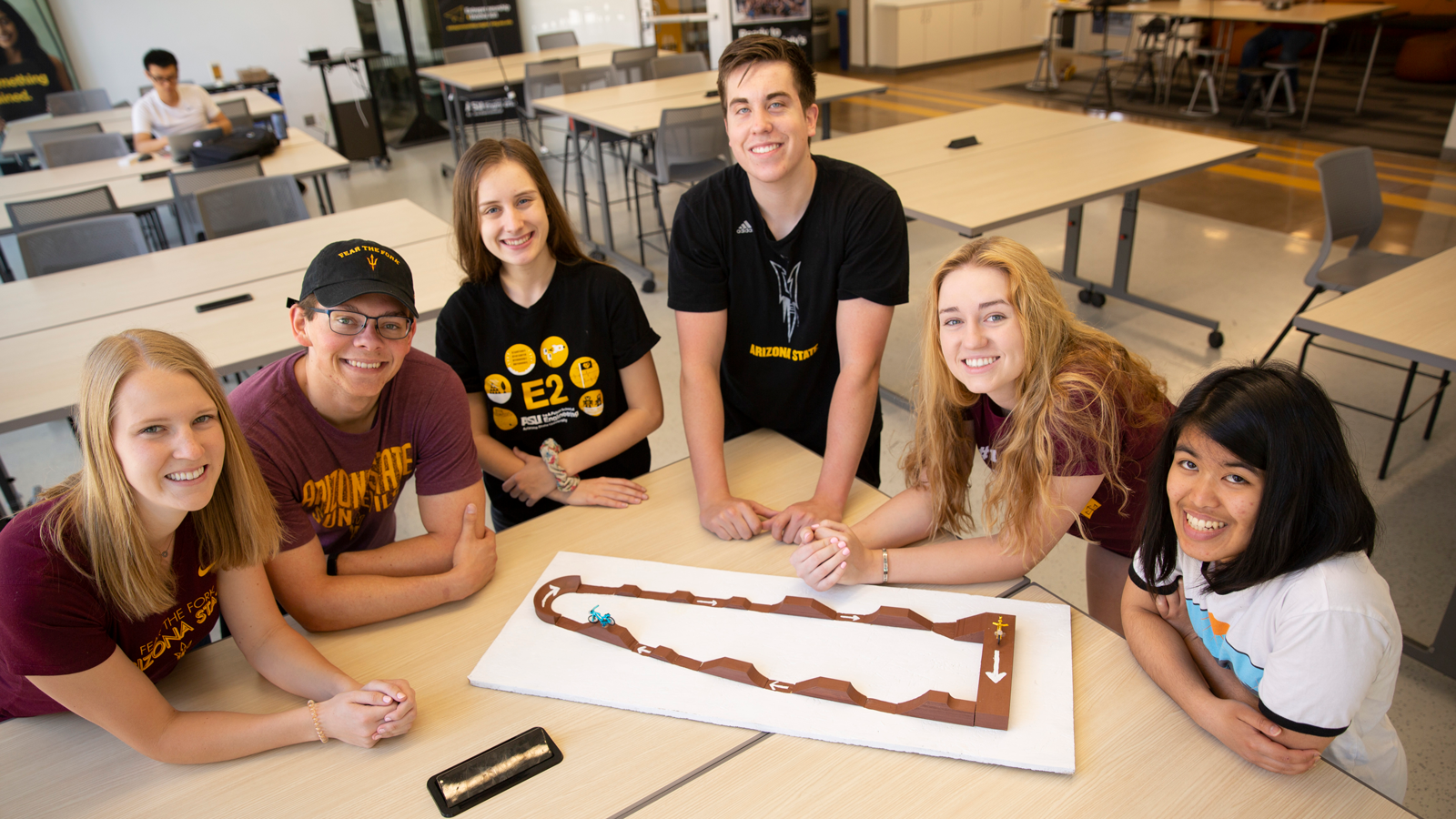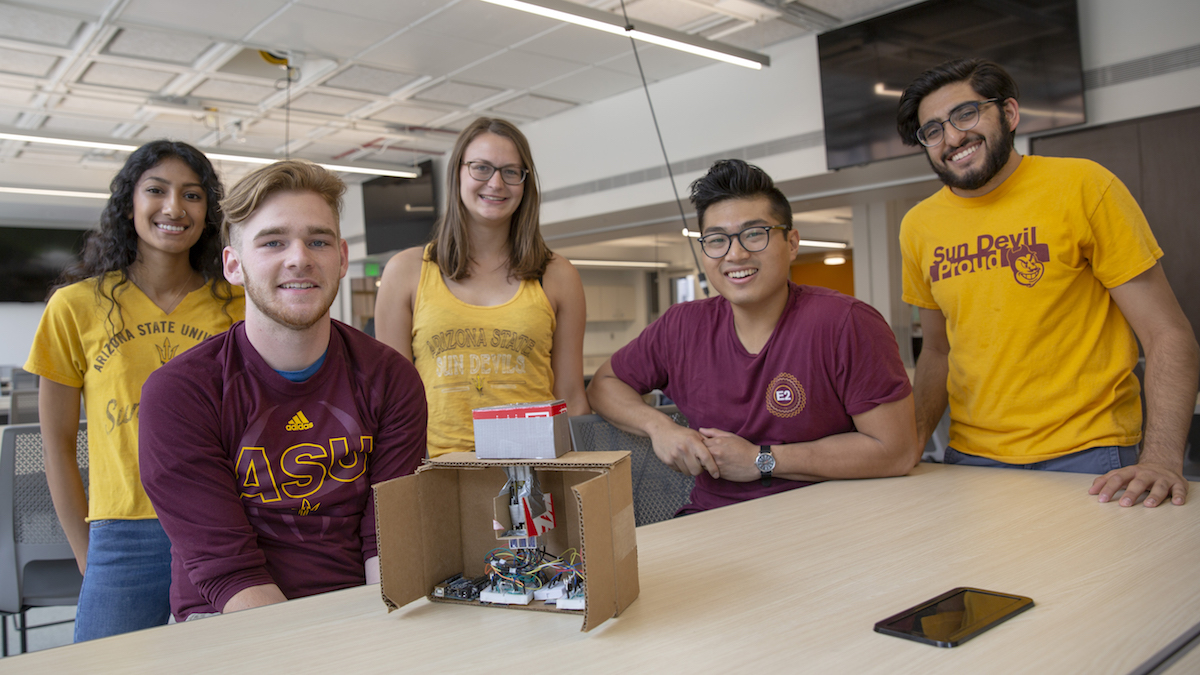
EPICS Elite Pitch Competition expands impact of student projects

Above: Water in Peru team members (from left to right) Samantha Stone, Daniel Hoop and Brett Goldsmith examine water quality. This EPICS team, which is working to solve the global problem of water purification monitoring, earned first place and $1,500 at the first EPICS Elite Pitch Competition. Photographer: Erika Gronek/ASU
The Engineering Projects in Community Service program, better known as EPICS, in the Ira A. Fulton Schools of Engineering at Arizona State University provides students the knowledge, funding and opportunity to work on real projects with actual clients who are facing social or environmental problems. Through these projects, students gain real-world experience and acquire skills that are highly valued when they enter the job market.
This year, the Fulton Schools held the first ever EPICS Elite Pitch Competition with a total of eight teams selected to compete out of the more than 40 EPICS projects currently in progress. Each team developed a five-minute pitch detailing their solution, its implementation, and their plans to grow and scale their ideas.
“The EPICS Elite Pitch Competition was created to allow student teams an opportunity to obtain additional funding to implement their solutions, which will create value and provide a positive impact on the communities they are working with,” says Jared Schoepf, EPICS director of operations and lecturer.
The first-place team, Water in Peru, was awarded $1,500; the second-place team, Shonto Pump Track, was awarded $1,000; and the third-place team, Bridge2Africa, received $500.

Students (from left to right) Brett Goldsmith, Samantha Stone and Daniel Hoop show a prototype of their autonomous chlorine disinfection system created as part of the Engineering Projects in Community Service program. The Water in Peru team earned first place in the EPICS Elite Pitch Competition. Photographer: Erika Gronek/ASU
Water in Peru
The Water in Peru team is working to solve the global problem of monitoring chlorine concentrations for disinfecting water. They are developing a continuous and autonomous chlorine disinfection system alongside 33 Buckets. The Water in Peru team’s system utilizes chlorine tablets to remove E. coli bacteria from reservoirs that provide drinking water to communities in Peru.
“Chlorine disinfection requires a consistent, precise dose to be effective against bacterial contamination over time,” says Daniel Hoop, an environmental engineering major and the Water in Peru team lead. “The primary goal of our system is to make the dosing of chlorine in drinking water systems more user-friendly.”
In order to improve usability, the team designed and prototyped a tablet chlorination system that contains an adjustable ball valve to change chlorine exposure to water flowing into a community’s reservoir.
The second aspect of the system is automatic monitoring of residual chlorine levels.
“Residual chlorine is the parameter set by the World Health Organization to confirm that drinking water is safe to consume after disinfection,” explains Hoop. “Currently, many communities lack the resources and training to properly test for residual chlorine. As a result, we are working on a sensor that continuously and automatically tests for the residual chlorine level in water without the need for reagents.”
The sensor is completely solar powered and compact; it can fit in a lunch-box-sized encasing. The goal of the sensor is to supplement manual water quality testing with remote monitoring through data collection. To confirm the effectiveness of the system, the team created a manual testing training that they will also provide to community members.
Hoop says that he worked with 33 Buckets because of the alignment of the project’s mission and the organization’s origins as a former EPICS project.
“The EPICS program provides a platform for undergraduates to work through the engineering design process with a community partner on an actual solution for a client,” says Hoop. “The program provides support in the form of advisers, prototyping labs and funding opportunities to allow for projects to manifest into real-world solutions.”
Water in Peru team members
• Daniel Hoop, environmental engineering
• Samantha Stone, environmental engineering
• Zachary Kobza, civil engineering
• Brett Goldsmith, engineering (electrical systems)
• Mauro Robles, biomedical engineering
• Dev Patel, chemical engineering

Students (from left to right) Aly Carlson, Alexander Owen, Emma Pedersen, Christian Messner, Danielle Seedon and Jocelyn Zaman show off a model of a mountain biking pump track they designed for the Navajo Nation community of Shonto as part of the Engineering Projects in Community Service program. The Shonto Pump Track team earned second place at the EPICS Elite Pitch Competition. Photographer: Erika Gronek/ASU
Shonto Pump Track
The Navajo Nation is currently facing a public health crisis and community leaders want to incorporate some form of physical exercise that will promote a healthy lifestyle in the community.
The Shonto Pump Track team is partnering with the community of Shonto on the Navajo Nation to use mountain biking as a way to provide economic development and promote public health by creating mountain bike pump tracks.
Pump tracks are looped trails with small hills riders maneuver to gain momentum and propel themselves forward without pedaling. This technique is called “pumping.”
“We have built a pump track at the local elementary school and are in the process of building a larger one at the community center,” says Aly Carlson, a chemical engineering major. “These pump tracks give the students a place to learn mountain biking skills while helping address the public health crisis.”
The team is also building mountain biking trails that they hope will bring tourists to the town.
“They will be able to grow their economy in the form of restaurants, hotels, bike shops and other service industries,” says Carlson. “This would allow people to work close to home and their families. We have mapped out a 12-mile trail and are waiting on land rights before we can move forward with building.”
Carlson, who has been working on this project for three years, says she has a personal connection to the project.
“I started working on this project because I love biking and being outdoors,” says Carlson. “I liked this project because I saw it as an opportunity to help a large group of people and make an impact.”
Shonto Pump Track team members
• Aly Carlson, chemical engineering
• Danielle Seddon, mechanical engineering
• Alexander Owen, civil engineering
• Christian Messner, mechanical engineering
• Jocelyn Zaman, computer systems engineering
• Kinshuk Agrawal, computer science
• Emma Pedersen, aerospace engineering

Students (from left to right) Nadia Jafar, Robert Lattus, Abbey Jansen, Philipe Adriane Inocencio and Rajat Arora show a prototype of a device that converts online text on a webpage to Braille. This project was part of the Engineering Projects in Community Service team Bridge2Africa, which earned third place at the EPICS Elite Pitch Competition. Photographer: Erika Gronek/ASU
Bridge2Africa
The Bridge2Africa team is working to convert internet text to Braille to help bring online access to students at the Sibonile Schools for the Visually Impaired in South Africa.
“Our solution uses a software and hardware approach to allow students who are visually impaired to navigate the internet,” says Rajat Arora, an electrical engineering major.
The next steps for the team include designing and prototyping the hardware portion of their solution, which includes a physical Braille display.
“Our software portion revolves around building a screen reader from scratch that parses through webpages,” says Arora. “This allows the user to decide whether the text is ready via audio feedback or through the Braille keyboard.”
Arora explains the members of the Bridge2Africa team all wanted to get involved in an EPICS project for the same reason: They wanted to contribute to an idea they could see implemented by the end of their college careers.
“As we progress through our engineering majors, we noticed that nearly everyone is the same: we all take the same classes, have the same technical skills and apply for the same internships,” says Arora. “At the end of the day, we wanted to be able to see an idea to the end that we had a significant impact on, and see a community prosper from it.”
Bridge2Africa team members
• Rajat Arora, electrical engineering
• Nadia Jafar, computer systems engineering
• Abbey Jansen, chemical engineering
• Phillippe Adriane Inocencio, computer systems engineering
• Robert Lattus, electrical engineering
These projects represent only three of the student-led endeavors developed to solve problems around the world. Fulton Schools students have been participating in EPICS projects since 2009 when ASU joined a consortium of 20 universities in the nationwide EPICS program.



































